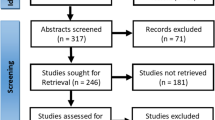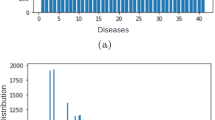Abstract
In the era of data, major decisions are determined by massive data, especially in the healthcare industry. In this paper, an intelligent data-driven model is proposed based on machine learning theory, specifically, support vector machine (SVM) and random forest (RF). The model is then applied to a case of disease diagnosis, cough variant asthma (CVA). The data of 137 samples with 12 attributes is collected for experiments. The results show that the proposed model achieves better prediction performance than single SVM and single RF. Besides, in order to identify the key medical indicators to enhance diagnosis accuracy and efficiency, the most important factors affecting CVA are generated by the proposed model, including FENO, EOS%, MMEF75/25, FEV1/FVC, PEF, etc. Meanwhile, it is demonstrated that the proposed model could be a user-friendly tool to improve the performance of disease diagnosis.




Similar content being viewed by others
References
Alam MGR, Haw R, Kim SS, Azad MAK, Abedin SF, Hong CS (2016) Em-psychiatry: an ambient intelligent system for psychiatric emergency. IEEE Trans Ind Inform 12(6):2321–2330
Bahri S, Zoghlami N, Abed M, Tavares JMR (2018) Big data for healthcare: a survey. IEEE Access 7:7397–7408
Bai Y, Han X, Chen T, Yu H (2015) Quadratic kernel-free least squares support vector machine for target diseases classification. J Combin Optim 30(4):850–870
Bertsimas D, O’Hair A, Relyea S, Silberholz J (2016) An analytics approach to designing combination chemotherapy regimens for cancer. Manag Sci 62(5):1511–1531
Calderoni L, Ferrara M, Franco A, Maio D (2015) Indoor localization in a hospital environment using random forest classifiers. Exp Syst Appl 42(1):125–134
Cao X, Liu L, Cheng Y, Shen XS (2017) Towards energy-efficient wireless networking in the big data era: a survey. IEEE Commun Surv Tutor 20(1):303–332
Cortes C, Vapnik V (1995) Support-vector networks. Mach Learn 20(3):273–297
Dapogny A, Bailly K, Dubuisson S (2018) Confidence-weighted local expression predictions for occlusion handling in expression recognition and action unit detection. Int J Comput Vis 126(2–4):255–271
Dongxiao N, Tiannan M, Bingyi L (2017) Power load forecasting by wavelet least squares support vector machine with improved fruit fly optimization algorithm. J Combin Optim 33(3):1122–1143
Gai L, Ji J (2019) An integrated method to solve the healthcare facility layout problem under area constraints. J Combin Optim 37(1):95–113
Gao W, Bao W, Zhou X (2019) Analysis of cough detection index based on decision tree and support vector machine. J Combin Optim 37(1):375–384
Jin C, Shi F, Xiang D, Jiang X, Zhang B, Wang X, Zhu W, Gao E, Chen X (2016) 3D fast automatic segmentation of kidney based on modified AAM and random forest. IEEE Trans Med Imaging 35(6):1395–1407
Khanmohammadi S, Adibeig N, Shanehbandy S (2017) An improved overlapping k-means clustering method for medical applications. Expert Syst Appl 67:12–18
Liu L, Tang G, Fan B, Wang X (2015) Two-person cooperative games on scheduling problems in outpatient pharmacy dispensing process. J Combin Optim 30(4):938–948
Shevchik SA, Saeidi F, Meylan B, Wasmer K (2016) Prediction of failure in lubricated surfaces using acoustic time-frequency features and random forest algorithm. IEEE Trans Ind Inform 13(4):1541–1553
Thong NT et al (2015) Hifcf: an effective hybrid model between picture fuzzy clustering and intuitionistic fuzzy recommender systems for medical diagnosis. Expert Syst Appl 42(7):3682–3701
Tsyurmasto P, Zabarankin M, Uryasev S (2014) Value-at-risk support vector machine: stability to outliers. J Combin Optim 28(1):218–232
Yadav P, Steinbach M, Kumar V, Simon G (2018) Mining electronic health records (EHRS): a survey. ACM Comput Surv (CSUR) 50(6):85
Yang Y, Shen B, Gao W, Liu Y, Zhong L (2015) A surgical scheduling method considering surgeons’ preferences. J Combin Optim 30(4):1016–1026
Zhang Y, Qiu M, Tsai CW, Hassan MM, Alamri A (2015) Health-CPS: healthcare cyber-physical system assisted by cloud and big data. IEEE Syst J 11(1):88–95
Zhong L, Bai Y (2019) Three-sided stable matching problem with two of them as cooperative partners. J Combin Optim 37(1):286–292
Acknowledgements
This research is supported by five projects: The project of Shanghai Shenkang hospital development center, clinical science and technology optimization (SHDC12017623); The doctoral start-up project of USST (BSQD201901); National natural science foundation of China (71840003, 71801150); The scientific and technological development project of USST (2018KJFZ043).
Author information
Authors and Affiliations
Corresponding author
Additional information
Publisher's Note
Springer Nature remains neutral with regard to jurisdictional claims in published maps and institutional affiliations.
Rights and permissions
About this article
Cite this article
Huang, H., Gao, W. & Ye, C. An intelligent data-driven model for disease diagnosis based on machine learning theory. J Comb Optim 42, 884–895 (2021). https://doi.org/10.1007/s10878-019-00495-x
Published:
Issue Date:
DOI: https://doi.org/10.1007/s10878-019-00495-x




